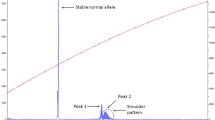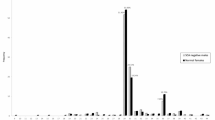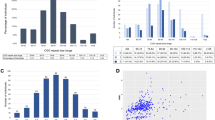Abstract
Within the past few years, there has been a significant change in identifying and characterizing the FMR1 premutation associated phenotypes. The premutation has been associated with elevated FMR1 mRNA levels and slight to moderate reductions in FMRP levels. Furthermore, it has been established that ∼20% of female premutation carriers present primary ovarian insufficiency (POI) and that fragile X-associated tremor/ataxia syndrome (FXTAS) occurs in one-third of all male premutation carriers older than 50 years. Besides POI and FXTAS, new disorders have recently been described among individuals (especially females) with the FMR1 premutation. Those pathologies include thyroid disease, hypertension, seizures, peripheral neuropathy, and fibromyalgia. However there are few reports related to FXTAS penetrance among female premutation carriers or regarding these disorders recently associated to the FMR1 premutation. Therefore, we have evaluated 398 fragile X syndrome (FXS) families in an attempt to provide an estimation of the premutation associated phenotypes penetrance. Our results show that signs of FXTAS are detected in 16.5% of female premutation carriers and in 45.5% of premutated males older than 50 years. Furthermore, among females with the FMR1 premutation, penetrance of POI, thyroid disease and chronic muscle pain is 18.6, 15.9 and 24.4%, respectively. The knowledge of this data might be useful for accurate genetic counselling as well as for a better characterization of the clinical phenotypes of FMR1 premutation carriers.
Similar content being viewed by others
Log in or create a free account to read this content
Gain free access to this article, as well as selected content from this journal and more on nature.com
or
References
Rife M, Badenas C, Mallolas J et al: Incidence of fragile X in 5000 consecutive newborn males. Genet Test 2003; 7: 339–343.
Rousseau F, Rouillard P, Morel ML, Khandjian EW, Morgan K : Prevalence of carriers of premutation-size alleles of the FMRI gene--and implications for the population genetics of the fragile X syndrome. Am J Hum Genet 1995; 57: 1006–1018.
Dombrowski C, Lévesque S, Morel ML, Rouillard P, Morgan K, Rousseau F : Premutation and intermediate-size FMR1 alleles in 10 572 males from the general population: loss of an AGG interruption is a late event in the generation of fragile X syndrome alleles. Hum Mol Genet 2002; 11: 371–378.
Cronister A, Schreiner R, Wittenberger M, Amiri K, Harris K, Hagerman RJ : Heterozygous fragile X female: historical, physical, cognitive, and cytogenetic features. Am J Med Genet 1991; 38: 269–274.
Hagerman RJ, Leehey M, Heinrichs W et al: Intention tremor, parkinsonism, and generalized brain atrophy in male carriers of fragile X. Neurology 2001; 57: 127–130.
Hagerman PJ, Hagerman RJ : The fragile X premutation: a maturing perspective. Am J Hum Genet 2004; 74: 805–816.
Tassone F, Hagerman RJ, Taylor AK, Gane LW, Godfrey TE, Hagerman PJ : Elevated levels of FMR1 mRNA in carrier males: a new mechanism of involvement in the fragile X syndrome. Am J Hum Genet 2000a; 66: 6–15.
Tassone F, Hagerman RJ, Taylor AK et al: Clinical involvement and protein expression in individuals with the FMR1 premutation. Am J Med Genet 2000b; 91: 144–152.
Coffey SM, Cook K, Tartaglia N et al: Expanded clinical phenotype of women with the FMR1 premutation. Am J Med Genet A 2008; 146A: 1009–1016.
Jacquemont S, Farzin F, Hall D et al: Aging in individuals with the FMR1 mutation. Am J Ment Retard 2004; 109: 154–164.
Allingham-Hawkins DJ, Babul-Hirji R, Chitayat D et al: Fragile X premutation is a significant risk factor for premature ovarian failure: the International Collaborative POI in Fragile X study--preliminary data. Am J Med Genet 1999; 83: 322–325.
Mallolas J, Duran M, Sanchez A et al: Implications of the FMR1 gene in menopause: study of 147 Spanish women. Menopause 2001; 8: 106–110.
Jacquemont S, Hagerman RJ, Leehey MA et al: Penetrance of the fragile X-associated tremor/ataxia syndrome in a premutation carrier population. JAMA 2004; 291: 460–469.
Loesch DZ, Churchyard A, Brotchie P, Marot M, Tassone F : Evidence for, and a spectrum of, neurological involvement in carriers of the fragile X pre-mutation: FXTAS and beyond. Clin Genet 2005; 67: 412–417.
Jacquemont S, Hagerman RJ, Hagerman PJ, Leehey MA : Fragile X syndrome and fragile X-associated tremor/ataxia syndrome: two faces of FMR1. Lancet Neurol 2007; 6: 45–55.
Berry-Kravis E, Abrams L, Coffey SM et al: Fragile X-associated tremor/ataxia syndrome: clinical features, genetics, and testing guidelines. Mov Disord 2007; 22: 2018–2030.
Canaris GJ, Manowitz NR, Mayor G, Ridgway EC : The Colorado thyroid disease prevalence study. Arch Intern Med 2000; 160: 526–534.
Wolfe F, Ross K, Anderson J, Russell IJ, Hebert L : The prevalence and characteristics of fibromyalgia in the general population. Arthritis Rheum 1995; 38: 19–28.
Crofford LJ, Pillemer SR, Kalogeras KT et al: Hypothalamic-pituitary-adrenal axis perturbations in patients with fibromyalgia. Arthritis Rheum 1994; 37: 1583–1592.
Arnold LM : Management of fibromyalgia and comorbid psychiatric disorders. J Clin Psychiatry 2008; 69: 14–19.
Goldenberg DL : Introduction: fibromyalgia and its related disorders. J Clin Psychiatry 2008; 69: 4–5.
Johnston C, Eliez S, Dyer-Friedman J et al: Neurobehavioral phenotype in carriers of the fragile X premutation. Am J Med Genet 2001; 103: 314–319.
Rodriguez-Revenga L, Madrigal I, Alegret M, Santos M, Mila M : Evidence of depressive symptoms in fragile X syndrome premutated females. Psychiatr Genet 2008; 18: 153–155.
Acknowledgements
We thank the Fragile X families, the ‘Associació Catalana Síndrome X fràgil’, and the Federación Española del Síndrome X Frágil for their cooperation. This work was supported by MARATO TV3 (TV06-0810). The CIBER de Enfermedades Raras is an initiative of the ISCIII.
Author information
Authors and Affiliations
Corresponding author
Rights and permissions
About this article
Cite this article
Rodriguez-Revenga, L., Madrigal, I., Pagonabarraga, J. et al. Penetrance of FMR1 premutation associated pathologies in fragile X syndrome families. Eur J Hum Genet 17, 1359–1362 (2009). https://doi.org/10.1038/ejhg.2009.51
Received:
Revised:
Accepted:
Published:
Issue date:
DOI: https://doi.org/10.1038/ejhg.2009.51
Keywords
This article is cited by
-
Spectrum of Syndromal Disorders Associated with Expansion of CGG Repeats of the FMR1 Gene Promoter: Pathogenetic Mechanisms and Clinical Manifestations
Neuroscience and Behavioral Physiology (2023)
-
Atypical vocal quality in women with the FMR1 premutation: an indicator of impaired sensorimotor control
Experimental Brain Research (2023)
-
Family history of FXTAS is associated with age-related cognitive-linguistic decline among mothers with the FMR1 premutation
Journal of Neurodevelopmental Disorders (2022)
-
Neuropsychological changes in FMR1 premutation carriers and onset of fragile X-associated tremor/ataxia syndrome
Journal of Neurodevelopmental Disorders (2022)
-
Neurodegenerative diseases associated with non-coding CGG tandem repeat expansions
Nature Reviews Neurology (2022)



